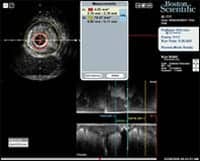Virtual colonoscopy or CT colonography is a promising new method for colorectal cancer screening. Helical CT of the abdomen and pelvis is used to generate high-resolution, two-dimensional axial images of the air-distended cleansed colon. This data can be reconstructed into three-dimensional images of the colonic lumen that are similar to those obtained with conventional colonoscopy.
Several studies published over the past year have demonstrated the feasibility of virtual colonoscopy as a screening tool.1-5 Key drivers for virtual colonoscopy include its safety profile, high patient acceptance, and ability to provide a full structural evaluation of the entire colon. However, less attention has been paid to the economic issues related to its use in clinical practice.
In recent years, patients have become increasingly knowledgeable and interested in their own health care and treatment. This has led to the emergence of self-referrals, whereby patients request medical diagnostic services directly without referrals from their clinician. Coupled with this rise in self-referrals, patients have also become more willing to assume the cost of the medical tests themselves. These two conditions have led to the growth of fee-for-service imaging centers across the United States.
Along with calcium scoring and total body CT scanning, virtual colonoscopy has captured the interest of the general public as a useful and, in some cases, preferable screening method. Although patient charges vary across the country, the average fees for virtual colonoscopy screening are approximately $650 – $1,200. Most insurance companies do not currently reimburse virtual colonoscopy as a screening study. However, some insurers will cover virtual colonoscopy on a case-by-case basis where there is clinical indication for the examination. Acceptable clinical indications vary among insurance carriers but can include failed colonoscopy, rectal bleeding, positive fecal occult blood test (FOBT), and inability to tolerate conventional colonoscopy.
If the patient can obtain written approval from an insurer in advance of the study, the screening facility or radiologist should be confident that reimbursement would apply once the study is performed. However, in most cases, the procedure should be prepaid in full by the patient prior to booking the appointment or the completion of the study. The screening facility should offer to submit a courtesy claim to the insurer in an effort to assist the patient in recovering payment directly from the patient’s insurance company.
Non-Medicare patients should sign a Payment Responsibility form, which states that most insurance companies do not currently reimburse virtual colonoscopy and, as a result, the patient will assume the cost of the procedure. Privately insured patients or those with HMO insurance plans should be expected to remit payment prior to the procedure being performed.
Patients with Medicare will also be required to sign a waiver informing them that virtual colonoscopy is a noncovered service, which requires the patient to accept responsibility for the payment in full. Initially, the patient’s Medicare carrier will be billed and, upon denial of the claim, which is expected, the patient will be billed directly for the entire charge.
Currently, there is no CPT code designed specifically for virtual colonoscopy. Billing codes unique to each practice need to be created to allow tracking of the procedure and the generation of a bill or claim form in the event the patient requests the information. If an insurance company agrees to cover the service, the procedure can be thought of as equivalent to the following codes: 72192 (CT Scan Pelvis), 74150 (CT Scan Abdomen), and 76375 (CT 3D Reconstruction).
For service providers, there are considerable advantages resulting from direct patient payment rather than the more typical insurance company payment model. Since the patient generally pays at the time of service (or before), no billing process is necessary. This dramatically reduces the cost of service as there is no need to file insurance claim paperwork, send out billing notices, or resubmit rejected claims. Direct payments typically save approximately 10% to 15% of these costs. In addition, since the money is received earlier, there is the added advantage of improved cash flow and investment possibilities.
The business case for virtual colonoscopy must also be viewed from the standpoint of the cost of service to the organization. Expenditure will depend on CT scanner room time, technologist time, radiologist interpretation time, filming cost, and archive cost, as well as the cost of various consumables (enema tip, insufflator bulb, tubing, etc). The total cost will vary widely depending on the local area; however, it should be no higher than $150 to $200. If the charge to the patient is set at $700 to $1,200, a net profit of approximately $500 to $1,050 per patient could be expected.
The one cost consideration that is not included in this estimate is that of the virtual colonoscopy workstation. This can be a considerable capital expense and it is therefore important to carefully research the options available.
Virtual colonoscopy workstations exist in a variety of forms, from expensive dedicated workstations costing over $115,000, to generic 3D workstations costing in the range of $20,000 – $24,000. The latest offerings now allow the purchase of dedicated 3D virtual colonoscopy software packages for around $30,000. At this price point, virtual colonoscopy answers the economic argument, offering organizations a payback in less than 4 months if they perform only a single study a day.
The introduction of virtual colonoscopy as an additional screening tool provides a unique win-win situation for patients and imaging organizations. For patients, this technique offers a comfortable and low-risk alternative for the screening of colorectal cancer. For organizations that offer the procedure, virtual colonoscopy offers the advantage of a rapid return on investment while serving the health care interests of its patients. The advent of competitively priced software will allow virtual colonoscopy to come of age, delivering an economically and clinically feasible tool for the detection and prevention of colorectal cancer.?
Matthew A. Barish, MD, is vice-chairman of radiology, Boston Medical Center, and chief medical adviser for a 3D software vendor.
References:
- Fenlon HM, Nunes DP, Schroy PC 3rd, Barish MA, Clarke PD, Ferrucci JT. A comparison of virtual and conventional colonoscopy for the detection of colorectal polyps. N Engl J Med. 1999;341:1496-503.
- Fletcher JG, Johnson CD, Welch TJ, et al. Optimization of CT colonography technique: prospective trial in 180 patients. Radiology. 2000;216:704-711.
- Yee J, Akerkar GA, Hung RK, et al. Colorectal neoplasia: performance characteristics of CT colonography for detection in 300 patients. Radiology. 2001;219:685-692.
- McFarland EG, Brink JA, Pilgram TK, et al. Spiral CT colonography: reader agreement and diagnostic performance with two- and three-dimensional image-display techniques. Radiology. 2001;218:375-383.
- Hara AK, Johnson CD, MacCarty RL, Welch TJ, McCollough CH, Harmsen WS. CT colonography: single- versus multi-detector row imaging. Radiology. 2001;219: 461-465.





